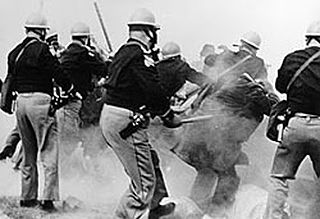Related Research Articles
Gary LaFree is a Professor and Chair of the Criminology and Criminal Justice department at the University of Maryland, College Park, the Director of the Maryland Crime Research and Innovation Center (MCRIC) and the Founding Director of the National Consortium for the Study of Terrorism and Responses to Terrorism (START). His main areas of expertise are sociology, criminology, race and crime, cross-national comparative research and political violence and terrorism.

Carjacking is a robbery in which the item taken over is a motor vehicle. In contrast to car theft, carjacking is usually in the presence and knowledge of the victim. A common crime in many places in the world, carjacking has been the subject of legislative responses, criminology studies, and prevention efforts. Commercial vehicles such as trucks and armored cars may be targets of carjacking attempts. Carjacking usually involve physical violence to the victim, similar to mugging.

The use of force, in the context of law enforcement, may be defined as the "amount of effort required by police to compel compliance by an unwilling subject".

Crime in Australia is managed by various law enforcement bodies, the federal and state-based criminal justice systems and state-based correctional services.
Law enforcement in the United States is one of three major components of the criminal justice system of the United States, along with courts and corrections. Although each component operates semi-independently, the three collectively form a chain leading from an investigation of suspected criminal activity to the administration of criminal punishment.

The Bureau of Justice Assistance (BJA) is a component of the Office of Justice Programs, within the United States Department of Justice. BJA provides leadership and assistance to local criminal justice programs that improve and reinforce the nation's criminal justice system.
Lawrence W. Sherman is an American experimental criminologist and police educator who is the founder of evidence-based policing.

The Ferguson Missouri Police Department (FPD) is a law enforcement agency serving Ferguson, Missouri. Since July 14, 2021, the Current Chief of Police has been Frank McCall Since Former Chief Jason Armstrong resigned.

Police brutality is the repression by personnel affiliated with law enforcement when dealing with suspects and civilians. The term is also applied to abuses by "corrections" personnel in municipal, state, and federal prison camps, including military prisons.
David L. Weisburd, is an Israeli/American criminologist who is well known for his research on crime and place, policing and white collar crime. Weisburd was the 2010 recipient of the prestigious Stockholm Prize in Criminology, and was recently awarded the Israel Prize in Social Work and Criminological Research, considered the state's highest honor. Weisburd holds joint tenured appointments as Distinguished Professor of Criminology, Law and Society at George Mason University. and Walter E. Meyer Professor of Law and Criminal Justice in the Institute of Criminology of the Hebrew University Faculty of Law, At George Mason University Weisburd was founder of the Center for Evidence-Based Crime Policy and is now its executive director. Weisburd also serves as Chief Science Advisor at the National Police Foundation in Washington, D.C., and chair of its Research Advisory Committee. Weisburd was the founding editor of the Journal of Experimental Criminology, and is now the general editor of the Journal of Quantitative Criminology.

A body camera, bodycam, body worn video (BWV), body-worn camera, or wearable camera is a wearable audio, video, or photographic recording system.

United States v. City of Portland was a lawsuit filed by the United States Department of Justice against the City of Portland, Oregon on December 17, 2012, alleging a pattern or practice of unconstitutional use of force by the Portland Police Bureau against individuals with actual or perceived mental illness.

"Hands up, don't shoot", sometimes shortened to "hands up", is a slogan and gesture that originated after the August 9, 2014, shooting of Michael Brown in Ferguson, Missouri, United States. The slogan implies one has their hands in the air, a common sign of submission, and is therefore not a threat to an approaching police officer. Witness reports from the Brown shooting are conflicted as to what Brown was doing with his hands when he was shot. Some witnesses claimed Brown had his hands in the air before being killed, although investigations later found that physical and forensic evidence contradicted witnesses who had claimed that Brown had his hands up when a police officer shot him. The slogan was adopted at protests against police brutality in the U.S.A. United States Department of Justice investigation claimed that the 'hands up' claim was inconsistent with the physical and forensic evidence.
The Academy of Criminal Justice Sciences (ACJS) is an international association established in 1963 to foster professional and scholarly activities in the field of criminal justice and criminology. ACJS promotes criminal justice and criminology education, policy analysis, and research for scholars, practitioners, and policymakers. Its national office is located in Greenbelt, MD, a suburb of Washington, D.C. in the US.
The Ferguson effect is a hypothesized increase in violent crime rates in a community caused by reduced proactive policing due to the community's distrust and hostility towards police. The Ferguson effect was first proposed after police saw an increase in violence following the 2014 shooting of Michael Brown in Ferguson, Missouri. The term was coined by Doyle Sam Dotson III, the chief of the St. Louis police, to account for an increased murder rate in some U.S. cities following the Ferguson unrest. Whether the Ferguson effect really exists is subject of discussions with many published studies reporting contradicting findings concerning whether there is a change in crime rates, number of 911 calls, homicides, and proactive policing. Furthermore, the effect and influence of the portrayal of police brutality in the media is also contested.
Kevin Michael Beaver is an American criminologist and the Judith Rich Harris Professor of Criminology at Florida State University's College of Criminology and Criminal Justice, where he is also the director of the Distance Learning Program.
Anthony Allan Braga is an American criminologist and the Jerry Lee Professor of Criminology at the University of Pennsylvania. Braga is also the Director of the Crime and Justice Policy Lab at the University of Pennsylvania. He previously held faculty and senior research positions at Harvard University, Northeastern University, Rutgers University, and the University of California at Berkeley. Braga is a member of the federal monitor team overseeing the reforms to New York City Police Department (NYPD) policies, training, supervision, auditing, and handling of complaints and discipline regarding stops and frisks and trespass enforcement.

In policing equipment, a body camera or wearable camera, also known as body worn video (BWV) or body-worn camera (BWC) or Bodycam, is a wearable audio, video, or photographic recording system used to record events in which law enforcement officers are involved. They are typically worn on the torso of the body on the officer's uniform. Body worn cameras for policing are often similar to other body worn video equipment used by civilians, firefighters, or the military, but are designed to address specific requirements related to law enforcement.
Wesley Glenn Jennings is an American criminologist.

Public criminology is an approach to criminology that disseminates criminological research beyond academia to broader audiences, such as criminal justice practitioners and the general public. Public criminology is closely tied with “public sociology”, and draws on a long line of intellectuals engaging in public interventions related to crime and justice. Some forms of public criminology are conducted through methods such as classroom education, academic conferences, public lectures, “news-making criminology”, government hearings, newspapers, radio and television broadcasting and press releases. Advocates of public criminology argue that the energies of criminologists should be directed towards "conducting and disseminating research on crime, law, and deviance in dialogue with affected communities." Public criminologists focus on reshaping the image of the criminal and work with communities to find answers to pressing questions. Proponents of public criminology see it as potentially narrowing "the yawning gap between public perceptions and the best available scientific evidence on issues of public concern", a problem they see as especially pertinent to matters of crime and punishment.
References
- ↑ Lopez, German (2017-07-21). "The failure of police body cameras". Vox. Retrieved 2017-09-24.
- ↑ Walsh, Jim (2015-04-29). "ASU study to focus on Tempe police use of body cams". USA Today. Retrieved 2017-09-24.
- 1 2 Friedman, Uri (2014-12-03). "Do Police Body Cameras Actually Work?". The Atlantic. Retrieved 2017-09-24.
- ↑ Staff (2014-09-05). "Can Body Cameras 'Civilize' Police Encounters?". NPR.org. Retrieved 2017-09-24.
- ↑ Capps, Kriston (2015-07-30). "Police Body Cameras: Coming Everywhere in 3 to 5 Years". CityLab. Retrieved 2017-09-24.